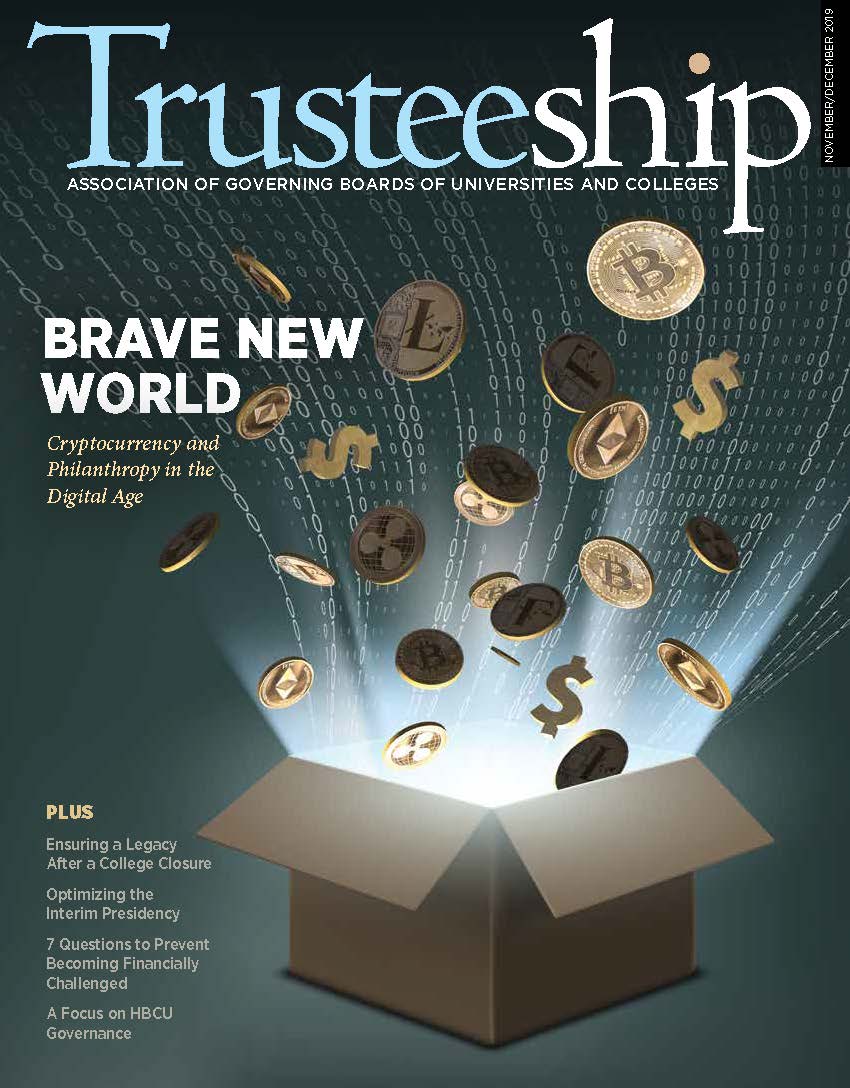Trusteeship: November/December
Volume 27, Number 6 // November/December 2019

Table of Contents
Features
A Brave New World: Cryptocurrency and 21st-Century Philanthropy
By Robert J. Nava and Venesia Thompson–Ramsay
The San Francisco State University received the largest gift of cryptocurrency in the United States to date in the fall of 2018. Gifts of cryptocurrency can present new challenges and opportunities for universities and institutionally related foundations. The San Francisco State University provides an example of a successful experience with cryptocurrency and shows lessons in how to navigate accepting such a gift.
Ensuring a Legacy after a College Closure: The Marygrove College Experience
By John C. Cavanaugh and Elizabeth A. Burns
Marygrove College was able to create a plan that kept its mission and legacy alive despite the closure of the college. This example gives other institutions a way forward when facing a closure of their own.
How to Optimize the Interim Presidency
By Kristin R. Tichenor
Interim presidencies happen more often than people realize. Trustees will likely face a leadership transition some point while on the board and an interim president may be part of this process. They must be prepared for this transitional period.
Seven Questions Every Board Should Be Asking to Prevent Becoming Financially Challenged
By Robert Witt and Kevin P. Coyne
Hearing of declining student enrollments that threaten an institution’s financial health is no longer a rare occurrence in higher education. Here are seven questions boards should ask to help guide their decisions to increase institutional value to students and help maintain the fiscal health of the institution.
Why Board Governance Matters: A Focus on HBCUs
By Alvin J. Schexnider
The leadership model at HBCUs have traditionally not allow for a strong governing board or shared governance as different standards, expectations, and treatment based on race affected HBCU’s board governance development. However, effective board governance is critical to helping HBCUs confront their challenges today and achieve their potential.
The Dartmouth Decision: Where Trustees Come From and How We Must Lead
By Andrew Lounder
The decision of the U.S. Supreme Court in Trustees of Dartmouth College v. William H. Woodward (1819) confirmed that boards of trustees bore the ultimate fiduciary responsibility for institutions of higher education. This case gave independent college boards the autonomy to govern an institution as a chartered corporate entity. These and other impacts are why the case is worthy of reflection by trustees today.
Departments
On My Agenda
Leadership and Accountability
By Henry Stoever
Perspective on the News
A sampling of national higher education news
Legal Standpoint
Crisis Management and the Law
By Steven Dunham
Focus on the Presidency
Student Need at a Turning Point
By Suzanne Shipley
View from the Board Chair
Embracing Change and Continuity
By Cathy Havener Greer
Inside AGB
New Guardians’ Business of Higher Education Brief
Podcast on the Role of University Research
Council of Presidents Meet in Washington, D.C.
AGB On Board
New Staff at AGB
A Question For…
Peter Smith
How Is College and Career Readiness Changing Higher Education?

